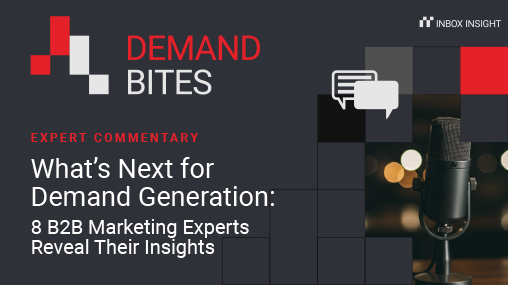B2B demand generation is constantly evolving, shaped by new strategies, technologies, and buyer behaviors. The Demand Bites podcast has gathered insights from leading B2B marketing experts about what’s working right now – and what will drive success throughout the year.
From building trust through thought leadership to using AI effectively, this article highlights expert-backed approaches you can use to refine your marketing strategies and drive sustainable growth for your organization.
Let’s dive into the demand generation trends and strategies discussed:
- Building trust through thought leadership
- Balancing long-term strategy with short-term needs
- Embracing personalization at scale
- Using AI to enhance, not replace
- Building resilient demand generation in uncertainty
- Full-funnel focus and the power of follow-up
- Aligning teams around shared goals and data
- Targeting the right audiences with your budget
Trend 1: Building trust through thought leadership
The old playbook of hard selling is losing ground. Today’s B2B buyers are looking for genuine expertise and trustworthy guidance, making it essential to build strong relationships and establish your authority through thought leadership.
Julie Smutko, Head of Demand Generation at Verse.ai, highlights this point: “Thought leadership is so important because it really gives you the opportunity to build trust with your ideal customer profile. It ties back to the idea that ‘helping will sell, selling won’t help’. If you can establish your brand as an expert, as a thought leader in the space, then your ideal customer profile will naturally turn to you when they need help with their job.”
B2B buyers typically spend around 10 hours per month researching solutions during a six-month sales cycle. Being consistently present with valuable, educational content throughout this extended research phase helps keep your brand top of mind when it’s time to make a decision.
Thought leadership plays a crucial role in this process. Sharing helpful insights positions your brand as more than just another vendor – it establishes you as a trusted expert in your field. This builds credibility and makes your brand the go-to resource buyers turn to for guidance, even before they’re ready to make a purchase.
Ultimately, this trust and authority gives you a competitive advantage, as companies are more likely to work with brands they view as knowledgeable and reliable.
- Read the full transcript: Building Trust Through Thought Leadership
- Listen to the full episode: Spotify | Apple Podcast
Trend 2: Balancing long-term strategy with short-term needs
Demand generation managers often find themselves walking a tightrope: delivering immediate pipeline results while simultaneously building long-term brand recognition and educational initiatives. Finding the right balance is critical – increasingly so as economic uncertainty drives greater pressure to show ROI.
Mike Hicks, CMO of AppSpace, shares his approach: “I really look at, given the budget that we have, are we generating enough top, middle, and bottom of the funnel to meet the current quarterly KPIs, as well as to set us up for the future? And where do we have the biggest need moving forward?”
Hicks highlights a common pitfall: focusing too much on bottom-funnel activities at the expense of top-of-funnel nurturing. Marketers can get caught up in the urgency of short-term results and fail to build a healthy pipeline for the future.
Our experts suggest that successful demand generation strategies should:
- Allocate resources across the full funnel based on data around conversion rates and typical sales cycle lengths
- Avoid an exclusive focus on bottom-funnel tactics that might drive immediate results but create longer-term gap
- Consider your marketing team’s natural strengths when allocating resources, rather than assigning activities that don’t align with their expertise
Maintaining discipline around top-of-funnel investment – even when short-term pressures are high – is a hallmark of resilient demand generation strategies. The most successful organizations plan for both today’s KPIs and tomorrow’s opportunities, ensuring they never lose momentum.
- Read the full transcript: Balancing Strategy, Execution & Category Creation
- Listen to the full episode: Spotify | Apple Podcast
Trend 3: Embracing personalization at scale
Customers expect experiences that feel tailored, not templated. But how do you add a human touch in a world increasingly driven by automation? The answer lies in finding creative ways to personalize your outreach without sacrificing efficiency.
Tara Robertson (formerly Head of Demand Generation at Chili Piper) offers her perspective: “Anything that can be fully automated, to me, is no longer ABM. It has to have some personal touch. I know many people don’t want to hear that – they want to automate everything. But with AI making it easy to draft emails or even handle your entire SDR function, the only way to stand out is with that human touch. It’s often more work up front, but it’s worthwhile.”
Personalization can take many forms, from tailoring email content to using data to personalize website experiences. Key strategies include:
- Taking time to research prospects before outreach, instead of relying solely on automation
- Finding creative ways to show you’ve done your homework and have a genuine understanding of the prospect’s needs
- Automating only repetitive tasks to preserve authentic human connection
The key to success is to “market how you wish you would be marketed to,” as Robertson suggests. “If I were buying this tool, what would I want to know? What are the FAQs? How would I want to be sold and marketed to? And try to keep that top of mind.”
- Read the full transcript: Build Trust and Creativity in Demand Gen
- Listen to the full episode: Spotify | Apple Podcast
Trend 4: Using AI to enhance, not replace
Artificial intelligence is reshaping B2B marketing. While it can help businesses streamline tasks like content creation and data analysis, the real winners will be those who use AI to enhance human expertise and creativity, not replace it.
Pam Didner, consultant and fractional CMO, emphasizes the importance of adaptability: “The one thing I would like to share with all marketers is the ability to learn. Technology is constantly evolving, and it impacts how marketing needs to be conducted – or even performed, if you will. We have to learn how to use AI to make our jobs a little easier. Never stop learning. That’s very important.”
Our experts agree: AI is best used to support marketers, helping generate first drafts, surface insights from data, and target campaigns more effectively. But it’s still human judgment, strategy, and creativity that drive results.
- Read the full transcript: Build Momentum in Your Demand Gen Strategy
- Listen to the full episode: Spotify | Apple Podcast
Trend 5: Building resilient demand generation in uncertainty
Economic shifts are continuing to shape marketing strategies, challenging teams to do more with less. To succeed in a fluctuating market, demand generation programs must be built for resilience, able to deliver consistent performance even when budgets tighten.
Jana Pelchen, demand generation expert, argues that marketers should be held accountable for revenue, not just leads: ” If you ask me right now which KPI I would pick, I would go for CAC Payback [the time it takes to recoup the cost of acquiring a customer]. For me, it has some clear pros: it’s a clear and simple benchmark, easy to understand, has a strong cash flow focus, and it helps evaluate the efficiency of demand generation initiatives.”
Demand generation managers must focus on building resilient programs driven by analytics to identify which channels deliver the best ROI. Staying grounded in long-term growth is key to avoiding panic-driven decisions, even during downturns.
By consistently monitoring key performance indicators (KPIs) and leveraging data-driven insights, you can optimize your marketing plans for cost-effectiveness. If a strategy is not working, it’s important to be ready to pivot.
- Read the full transcript: Recession-Proof Demand Generation: Strategies for Sustainable Growth
- Listen to the full episode: Spotify | Apple Podcast
Trend 6: Full-funnel focus and the power of follow-up
B2B buying processes have grown increasingly complex, with larger buying committees and longer decision cycles. To succeed, marketers need a full-funnel strategy that supports buyers throughout their journey and prioritizes consistent follow-up.
Natasha Tibbetts, VP of Media at Swell Media, highlights just how involved today’s buying process can be: “On average, you’ve got a buying committee of at least 10 people. Of those 10 people, each of them needs about an average of 16 touchpoints. And to boot on top of that, you’re competing against about three other vendors that are in the consideration set.”
This level of complexity demands a coordinated, multi-channel approach – one that combines educational content, tailored messaging, and persistent outreach to engage multiple stakeholders across the funnel. Marketers must be prepared to build trust over time, knowing that every touchpoint plays a role in influencing the final decision.
- Read the full transcript: Mastering the Full-Funnel Strategy
- Listen to the full episode: Spotify | Apple Podcast
Trend 7: Aligning teams around shared goals and data
For demand generation to be effective, sales and marketing teams must operate as a unified front. That means more than just shared metrics – it requires a cultural shift where both sides work collaboratively, communicate frequently, and share accountability for outcomes..
Samantha Ranieri, Senior Field Marketing Manager at Brandwatch and Cision, captures the complexity: “Demand gen can sometimes feel like a buzzword. People often just say: ‘Turn on the demand gen machine.’ But what lever do we pull? We could do ABM, a multi-touch campaign, an event, ad campaigns, social, SEO – there’s just so much nuance. We need to be more targeted. If lead gen or sales revenue is down, we need to know what levers to pull – and we should use data to help us, not just panic and pull as much as we can.”
Achieving this level of strategic focus means being transparent about what’s working and what isn’t, meeting regularly to review the data, and involving both teams in strategic decisions. When sales recognize the value of marketing’s contribution – and marketing is empowered to take ownership of pipeline and revenue – demand generation becomes far more targeted, effective, and resilient.
- Read the full transcript: The Art of Balancing Virtual and Physical Events
- Listen to the full episode: Spotify | Apple Podcast
Trend 8: Targeting the right audiences with your budget
With marketing budgets under constant scrutiny, targeting the right audiences is more important than ever. Success depends on focusing your efforts and resources on where it will have the greatest impact.
Ben Alvord, Director of Growth Marketing at Akamai Technologies, shares his approach:
“What I try to do is focus all of our ad spend dollars on programs where I know we’re in front of our ideal customer profile all the time. So we’re not wasting money advertising to people when there’s no chance they’re ever going to buy from us. And also the personas – obviously making sure that the money is getting our advertising in front of the correct job titles.”
To achieve this, Alvord favors LinkedIn and trusted ad networks that guarantee ICP-qualified leads, while moving away from less targeted tactics like paid search.
“There’s obviously a lot of value in paid search, but it’s basically impossible to stop yourself from getting clicks and leads from students and people just trying to educate themselves… your cost per MQL or opportunity is never going to be good. So we pretty much cut it entirely in favor of more efficient channels.”
This kind of focus may mean working with fewer platforms, but with a sharper targeting strategy, you’ll drive better performance from every dollar spent. Prioritize platforms that offer precise ICP targeting, work with vendors who can guarantee lead quality, and use account-based strategies to ensure your budget supports only the most promising opportunities.
- Read the full transcript: Power Up Your Demand Gen Strategy
- Listen to the full episode: Spotify | Apple Podcast
🎧 Watch bite-sized expert interviews from our Demand Bites guests
Explore conversations with our B2B marketing experts as they unpack the latest trends and strategies behind successful demand generation.
Demand Bites | Season 1: Demand Generation Insights

16:33

16:56

16:53

13:45

11:15

15:21

16:21

16:18
Conclusion: Setting up for success
Successful demand generation isn’t just about hitting quarterly targets, but about building a foundation for long-term, sustainable growth. The experts featured on the Demand Bites podcast agree: the strategies that matter most today focus on trust, alignment, agility, and authentic engagement.
Adapting to today’s B2B environment means moving away from transactional tactics and toward relationship-driven marketing, a core principle of modern B2B marketing strategies. The most successful teams are those who connect meaningfully with their audiences, deliver consistent value, and stay relevant throughout the entire buying journey.
By applying the strategies shared by our expert guests – which address critical demand generation trends like smarter use of AI to resilience through uncertainty – you can equip your team to thrive now and into the future.
For more actionable insights, tune into the Demand Bites podcast, where B2B marketing leaders share how they educate, engage, and convert their ideal customers.
Stay ahead of the curve. Subscribe to Demand Bites and hear from the voices shaping the future of B2B marketing.
Listen now on YouTube, Spotify, or Apple Podcasts.






